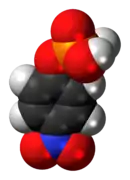para-Nitrophenylphosphate
para-Nitrophenylphosphate (pNPP) is a non-proteinaceous chromogenic substrate for alkaline and acid phosphatases used in ELISA and conventional spectrophotometric assays.[1] Phosphatases catalyze the hydrolysis of pNPP liberating inorganic phosphate and the conjugate base of para-nitrophenol (pNP). The resulting phenolate is yellow, with a maximal absorption at 405 nm.[2] This property can be used to determine the activity of various phosphatases including alkaline phosphatase (AP) and protein tyrosine phosphatase (PTP). We can also measure the concentration of enzyme using the property of absorbance. Spectrophotometry [3] is a technique in which we measure the amount of light absorbed by the sample, and from this absorbance using Beer–Lambert law[4] we can calculate the concentration of our enzyme by using the following equation.
| |||
| Names | |||
|---|---|---|---|
| IUPAC name
(4-nitrophenyl) dihydrogen phosphate | |||
| Other names
pNPP | |||
| Identifiers | |||
3D model (JSmol) |
|||
| ChEBI | |||
| ChEMBL | |||
| ChemSpider | |||
| ECHA InfoCard | 100.005.777 | ||
PubChem CID |
|||
CompTox Dashboard (EPA) |
|||
| |||
| |||
| Properties | |||
| C6H6NO6P | |||
| Molar mass | 219.09 | ||
| Related compounds | |||
Related compounds |
Paraoxon | ||
Except where otherwise noted, data are given for materials in their standard state (at 25 °C [77 °F], 100 kPa). | |||
| Infobox references | |||
A = ɛlc[5]
A is absorbance of the sample, ɛ is absorptivity coefficient, l is the length of light traveled in cm, and c is the concentration. From this equation we can see that concentration and absorbance are directly related. in other words, the absorbance will be higher for the sample with higher Protein (enzyme) concentration.
The substance is sensitive to light, and thus should be stored protected from light. This is also important after adding the substrate to the mixture and before reading. −20 °C is the optimal storage temperature.[6]
References
- Lorenz, Ulrike (2017-05-07). "Protein Tyrosine Phosphatase Assays". Current Protocols in Immunology. 91 (1): 11.7.1–12. doi:10.1002/0471142735.im1107s93. ISBN 978-0471142737. PMC 3097125. PMID 21462163.
- MacKintosh, C. (1993). In D.G. Hardie (Ed.). Protein Phosphorylation: A Practical Approach. 221. New York: IRL Press.
- Matsushima, Ayako; Inoue, Yorinao; Shibata, Kazuo (1975). "Derivative absorption spectrophotometry of native proteins". Analytical Biochemistry. 65 (1–2): 362–368. doi:10.1016/0003-2697(75)90520-5. ISSN 0003-2697. PMID 1169006.
- Mayerhöfer, Thomas G.; Mutschke, Harald; Popp, Jürgen (2016-04-05). "Employing Theories Far beyond Their Limits-The Case of the (Boguer-) Beer-Lambert Law". ChemPhysChem. 17 (13): 1948–1955. doi:10.1002/cphc.201600114. ISSN 1439-4235. PMID 26990241.
- Markwell, John (September 2009). "Fundamental laboratory approaches for biochemistry and biotechnology, 2nd edition". Biochemistry and Molecular Biology Education. 37 (5): 317–318. doi:10.1002/bmb.20321. ISSN 1470-8175.
- Biolabs, New England. "p-Nitrophenyl Phosphate (PNPP) - NEB". www.NEB.com. Retrieved 29 October 2017.

